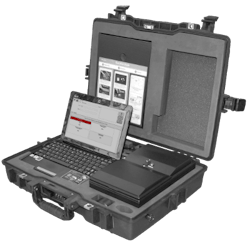Thorlabs ramps Raman spectroscopy expertise through Coda Devices acquisition

Effective as of August 1, 2019, Thorlabs (Newton, NJ) completed the acquisition of Coda Devices (Menlo Park, CA), a manufacturer of Raman-based solutions for analyzing the chemical composition of substances within a laboratory environment or out in the field. Based in California with an R&D center and production in Moscow, Russia, the Coda team will be integrated into Thorlabs’ Spectroscopy Technology Group in Munich, Germany.
Coda Device’s Raman spectrometers use patented coded-aperture technology that samples more than 1000 optical channels simultaneously, to achieve more than 30 times the light throughput of analogous diffraction slit spectrometers, thereby overcoming the light collection and overall sensitivity limitations of a small entrance aperture. By combining this high throughput aperture with extensive signal processing algorithms, the Coda Devices suppress unwanted fluorescence signals that would otherwise mask the detection of weak Raman signatures and achieve five times higher signal-to-noise ratios than standard diffraction-slit-based spectrometers.
With a 1.5 square millimeter analysis area—10,000 times larger than traditionally available laser spots—a lower-energy light source can be used, allowing for nondestructive analysis of heat-sensitive samples. The larger area also makes it possible to accurately identify a wider range of samples, including large-grain and non-homogeneous mixtures.
Coda says its technology can identify the relative concentrations of up to four different substance types (powders, liquids, gels, or solids) out of a current library of 3600 known signatures (prescription and illegal substances, polymers, plastics, minerals, and organic/inorganic compounds) in less than 15 seconds. The analysis can be performed through any transparent material (including baggies, blisters, glass ampoules), thereby eliminating the need to break into the initial packaging, which has the benefit of preventing contact with potentially deadly substances and allows the technology to be used for inline quality control.
“We are very excited to welcome the Coda team to Thorlabs and to gain their Raman Spectroscopy expertise,” said Verena Mackowiak, managing product engineer of Thorlabs’ Spectroscopy Technology Team. “In the coming weeks and months, we look forward to working together to expand the market reach of the coded-aperture Raman Spectroscopy technique.”
Anatoly Konukhov, CEO of Coda Devices, added, “We are highly passionate about this deal. Thorlabs’ proficiency in the field of optics will boost and drastically enhance the technology developed by the Coda team, increase areas of application, and subsequently expand the market reach of our products. I would also like to thank our investor, Phystech Ventures, for their support.”
SOURCE: Thorlabs; https://www.thorlabs.com/PressReleases.cfm?ReleaseID=106

Gail Overton | Senior Editor (2004-2020)
Gail has more than 30 years of engineering, marketing, product management, and editorial experience in the photonics and optical communications industry. Before joining the staff at Laser Focus World in 2004, she held many product management and product marketing roles in the fiber-optics industry, most notably at Hughes (El Segundo, CA), GTE Labs (Waltham, MA), Corning (Corning, NY), Photon Kinetics (Beaverton, OR), and Newport Corporation (Irvine, CA). During her marketing career, Gail published articles in WDM Solutions and Sensors magazine and traveled internationally to conduct product and sales training. Gail received her BS degree in physics, with an emphasis in optics, from San Diego State University in San Diego, CA in May 1986.